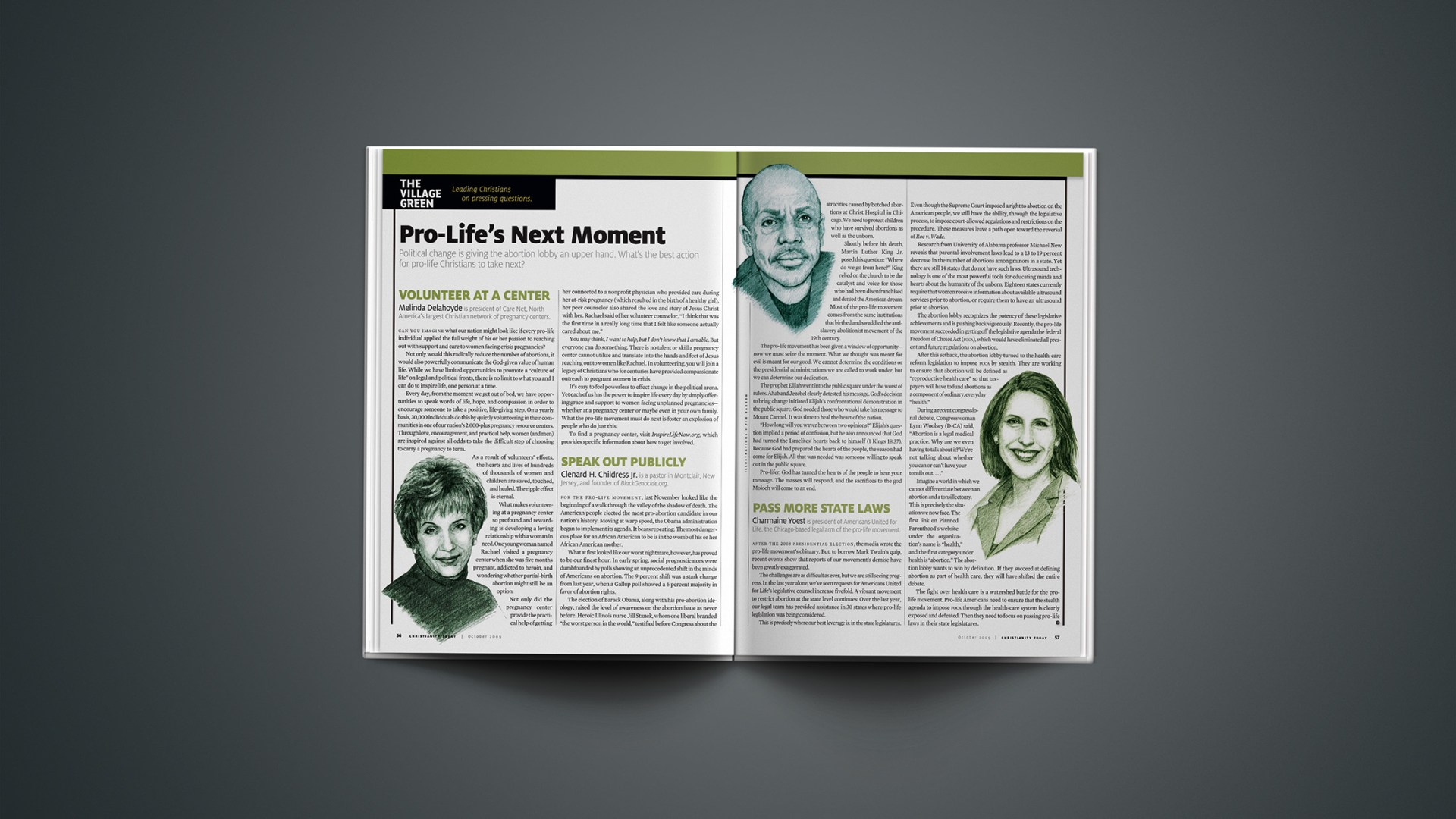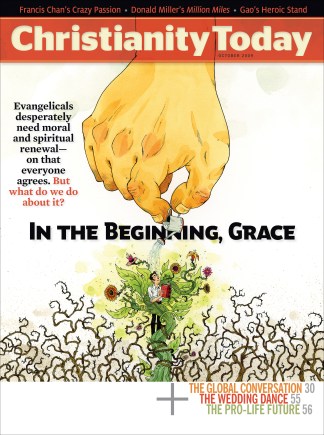Political change is giving the abortion lobby an upper hand. What’s the best action for pro-life Christians to take next? Melinda Delahoyde, president of Care Net, Clenard H. Childress Jr., founder of BlackGenocide.org., and Charmaine Yoest, president of Americans United for Life, suggest the next steps for the pro-life movement.
Volunteer at a Center
The pro-life movement’s next move is to foster an explosion of people who do support women facing unplanned pregnancies.
Melinda Delahoyde, president of Care Net
Can you imagine what our nation might look like if every pro-life individual applied the full weight of his or her passion to reaching out with support and care to women facing crisis pregnancies?
Not only would this radically reduce the number of abortions, it would also powerfully communicate the God-given value of human life. While we have limited opportunities to promote a “culture of life” on legal and political fronts, there is no limit to what you and I can do to inspire life, one person at a time.
Every day, from the moment we get out of bed, we have opportunities to speak words of life, hope, and compassion in order to encourage someone to take a positive, life-giving step. On a yearly basis, 30,000 individuals do this by quietly volunteering in their communities in one of our nation’s 2,000-plus pregnancy resource centers. Through love, encouragement, and practical help, women (and men) are inspired against all odds to take the difficult step of choosing to carry a pregnancy to term.
As a result of volunteers’ efforts, the hearts and lives of hundreds of thousands of women and children are saved, touched, and healed. The ripple effect is eternal.
What makes volunteering at a pregnancy center so profound and rewarding is developing a loving relationship with a woman in need. One young woman named Rachael visited a pregnancy center when she was five months pregnant, addicted to heroin, and wondering whether partial-birth abortion might still be an option.
Not only did the pregnancy center provide the practical help of getting her connected to a nonprofit physician who provided care during her at-risk pregnancy (which resulted in the birth of a healthy girl), her peer counselor also shared the love and story of Jesus Christ with her. Rachael said of her volunteer counselor, “I think that was the first time in a really long time that I felt like someone actually cared about me.”
You may think, I want to help, but I don’t know that I am able. But everyone can do something. There is no talent or skill a pregnancy center cannot utilize and translate into the hands and feet of Jesus reaching out to women like Rachael. In volunteering, you will join a legacy of Christians who for centuries have provided compassionate outreach to pregnant women in crisis.
It’s easy to feel powerless to effect change in the political arena. Yet each of us has the power to inspire life every day by simply offering grace and support to women facing unplanned pregnancies—whether at a pregnancy center or maybe even in your own family. What the pro-life movement must do next is foster an explosion of people who do just this.
To find a pregnancy center, visit www.InspireLifeNow.org, which provides specific information about how to get involved.
Speak Out Publicly
The pro-life movement needs people who are willing to speak out in the public square.
Clenard H. Childress Jr., founder of BlackGenocide.org.
For the pro-life movement, last November looked like the beginning of a walk through the valley of the shadow of death. The American people elected the most pro-abortion candidate in our nation’s history. Moving at warp speed, the Obama administration began to implement its agenda. It bears repeating: The most dangerous place for an African American to be is in the womb of his or her African American mother.
What at first looked like our worst nightmare, however, has proved to be our finest hour. In early spring, social prognosticators were dumbfounded by polls showing an unprecedented shift in the minds of Americans on abortion. The 9 percent shift was a stark change from last year, when a Gallup poll showed a 6 percent majority in favor of abortion rights.
The election of Barack Obama, along with his pro-abortion ideology, raised the level of awareness on the abortion issue as never before. Heroic Illinois nurse Jill Stanek, whom one liberal branded “the worst person in the world,” testified before Congress about the atrocities caused by botched abortions at Christ Hospital in Chicago. We need to protect children who have survived abortions as well as the unborn.
Shortly before his death, Martin Luther King Jr. posed this question: “Where do we go from here?” King relied on the church to be the catalyst and voice for those who had been disenfranchised and denied the American dream. Most of the pro-life movement comes from the same institutions that birthed and swaddled the anti-slavery abolitionist movement of the 19th century.
The pro-life movement has been given a window of opportunity—now we must seize the moment. What we thought was meant for evil is meant for our good. We cannot determine the conditions or the presidential administrations we are called to work under, but we can determine our dedication.
The prophet Elijah went into the public square under the worst of rulers. Ahab and Jezebel clearly detested his message. God’s decision to bring change initiated Elijah’s confrontational demonstration in the public square. God needed those who would take his message to Mount Carmel. It was time to heal the heart of the nation.
“How long will you waver between two opinions?” Elijah’s question implied a period of confusion, but he also announced that God had turned the Israelites’ hearts back to himself (1 Kings 18:37). Because God had prepared the hearts of the people, the season had come for Elijah. All that was needed was someone willing to speak out in the public square.
Pro-lifer, God has turned the hearts of the people to hear your message. The masses will respond, and the sacrifices to the god Moloch will come to an end.
Pass More State Laws
Pro-life Americans should focus on restricting abortion at the state level.
Charmaine Yoest, president of Americans United for Life
After the 2008 presidential election, the media wrote the pro-life movement’s obituary. But, to borrow Mark Twain’s quip, recent events show that reports of our movement’s demise have been greatly exaggerated.
The challenges are as difficult as ever, but we are still seeing progress. In the last year alone, we’ve seen requests for Americans United for Life’s legislative counsel increase fivefold. A vibrant movement to restrict abortion at the state level continues: Over the last year, our legal team has provided assistance in 30 states where pro-life legislation was being considered.
This is precisely where our best leverage is: in the state legislatures. Even though the Supreme Court imposed a right to abortion on the American people, we still have the ability, through the legislative process, to impose court-allowed regulations and restrictions on the procedure. These measures leave a path open toward the reversal of Roe v. Wade.
Research from University of Alabama professor Michael New reveals that parental-involvement laws lead to a 13 to 19 percent decrease in the number of abortions among minors in a state. Yet there are still 14 states that do not have such laws. Ultrasound technology is one of the most powerful tools for educating minds and hearts about the humanity of the unborn. Eighteen states currently require that women receive information about available ultrasound services prior to abortion, or require them to have an ultrasound prior to abortion.
The abortion lobby recognizes the potency of these legislative achievements and is pushing back vigorously. Recently, the pro-life movement succeeded in getting off the legislative agenda the federal Freedom of Choice Act (FOCA), which would have eliminated all present and future regulations on abortion.
After this setback, the abortion lobby turned to the health-care reform legislation to impose FOCA by stealth. They are working to ensure that abortion will be defined as “reproductive health care” so that taxpayers will have to fund abortions as a component of ordinary, everyday “health.”
During a recent congressional debate, Congresswoman Lynn Woolsey (D-CA) said, “Abortion is a legal medical practice. Why are we even having to talk about it? We’re not talking about whether you can or can’t have your tonsils out … .”
Imagine a world in which we cannot differentiate between an abortion and a tonsillectomy. This is precisely the situation we now face. The first link on Planned Parenthood’s website under the organization’s name is “health,” and the first category under health is “abortion.” The abortion lobby wants to win by definition. If they succeed at defining abortion as part of health care, they will have shifted the entire debate.
The fight over health care is a watershed battle for the pro-life movement. Pro-life Americans need to ensure that the stealth agenda to impose FOCA through the health-care system is clearly exposed and defeated. Then they need to focus on passing pro-life laws in their state legislatures.
Copyright © 2009 Christianity Today. Click for reprint information.
Related Elsewhere:
Melinda Delahoyde is president of Care Net, North America’s largest Christian network of pregnancy centers. Clenard H. Childress Jr. is a pastor in Montclair, New Jersey and founder of BlackGenocide.org. Charmaine Yoest is president of Americans United for Life, the Chicago-based legal arm of the pro-life movement.
Christianity Today‘s previous articles on abortion include:
Reducing Abortion for Real The current proposals to lower the abortion rate will only make things worse. A Christianity Today editorial (March 16, 2009)
We’re Not Finished | Abortion is not simply one item on our social agenda. (March 20, 2008)
Saving Black Babies | Abortion has cost 13 million African American lives. (February 1, 2003)
You Say Choice, I Say Murder | Before prolife arguments can reach the undecided American, we have got to look at the language we use. (June 24, 1991)
CT Classic: The Abortion Wars | What most Christians don’t know about the history of prolife struggles. (October 6, 1989)
Reversing Roe v. Wade | It may take more than a single court decision to counter abortion on demand. (September 20, 1985)
Abortion and the Court | The Roe v. Wade decision runs counter to the moral sense of the American people. (February 16, 1973)










